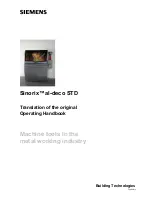
6
English
4. After installing new sanding paper
Movement of the sander may tend to become unsteady
after new sanding paper has been installed, because of
the new, coarse grain of the paper. This can be avoided
by slightly tilting the sander forward or backward during
sanding or polishing. Sander movement will become
steady as the sanding paper surface becomes properly
abraded.
MOUNTING THE OPTIONAL ACCESSORIES
1. Attaching a Sponge Pad (Velcro type) or a Stick-on
pad
Loosen the M4 × 10 screws (4) and remove the attached
pad. Next, attach a sponge pad (Velcro type) or a stick-
on pad.
CAUTION
Replace the pad only. Use the other parts without
removing them.
2. Attaching Velcro Type Sanding Paper or Stick-on
Type sanding Paper
Match the sanding paper’s hole with the pad’s hole and
strongly push the sanding paper with the palm of your
hand to fasten it securely in place.
3. Making a Hole in the Sanding Paper with the Punch
Plate (Fig. 6)
When using sanding paper without holes in it, punch
holes in it with the punch plate to improve dust collecting
capacity.
MAINTENANCE AND INSPECTION
1. Empting and cleaning the Dust Bag
If the dust bag contains too much saw dust, dust
collection will be a
ff
ected. Empty the dust bag when it
gets full.
Remove the dust bag, open the fastener, and dispose of
the contents.
2. Inspecting the sanding paper
Since use of worn-out sanding paper will degrade
e
ffi
ciency and cause possible damage to the pad,
replace the sanding paper as soon a excessive
abrasion is noted.
3. Inspecting the mounting screws:
Regularly inspect all mounting screws and ensure that
they are properly tightened. Should any of the screws
be loose, retighten them immediately. Failure to do so
could result in serious hazard.
4. Maintenance of the motor
The motor unit winding is the very “heart” of the power
tool.
Exercise due care to ensure the winding does not
become damaged and/or wet with oil or water.
5. Servicing
Consult an authorized Service Agent in the event of
power tool failure.
6. Service parts list
A:
Item
No.
B:
Code
No.
C:
No.
Used
D:
Remarks
CAUTION
Repair,
modi
fi
cation and inspection of HiKOKI Power
Tools must be carried out by an HiKOKI Authorized
Service Center.
This Parts List will be helpful if presented with the tool to
the HiKOKI Authorized Service Center when requesting
repair or other maintenance.
In the operation and maintenance of power tools, the
safety regulations and standards prescribed in each
country must be observed.
MODIFICATIONS
HiKOKI Power Tools are constantly being improved
and modi
fi
ed to incorporate the latest technological
advancements.
Accordingly, some parts (i.e. code numbers and/or
design) may be changed without prior notice.
GUARANTEE
We guarantee HiKOKI Power Tools in accordance with
statutory/country speci
fi
c regulation. This guarantee does
not cover defects or damage due to misuse, abuse, or
normal wear and tear. In case of complaint, please send
the Power Tool, undismantled, with the GUARANTEE
CERTIFICATE found at the end of this Handling instruction,
to a HiKOKI Authorized Service Center.
NOTE
Due to HiKOKI’s continuing program of research and
development, the speci
fi
cations herein are subject to
change without prior notice.
Information concerning airborne noise and vibration
The measured values were determined according to
EN60745 and declared in accordance with ISO 4871.
The typical A-weighted sound pressure level: 83 dB (A).
Uncertainty KpA: 3 dB (A).
Wear ear protection.
The typical weighted root mean square acceleration
value does not exceed 2.5 m/s
2
.
0000Book̲SV12SG̲EE.indb 6
0000Book̲SV12SG̲EE.indb 6
2017/11/16 16:55:22
2017/11/16 16:55:22








































